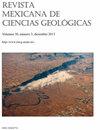Grajales等人,Rev. Mex对“古新世-始新世岩浆作用在哥伦比亚西部边缘的瞬变作用及其向动态平衡的演化”的评论。Cienc。Geol。(2020), 37(3), 250-268
IF 0.5
4区 地球科学
Q4 GEOSCIENCES, MULTIDISCIPLINARY
Revista Mexicana De Ciencias Geologicas
Pub Date : 2021-07-21
DOI:10.22201/CGEO.20072902E.2021.2.1615
引用次数: 0
摘要
Grajales等人(2020)审查了巴拿马-乔科地块(科迪勒拉西北部)、科迪勒拉西部南部以及哥伦比亚科迪勒勒拉中部出露的古近系火山岩和深成岩的地质年代和地球化学数据。这些数据用于支持哥伦比亚大陆边缘连续古近系弧岩浆作用的模型,并提出弧的古地理模型。作者没有讨论先前发表的古地磁、地球化学、地质年代学、热年代学和物源约束,从白垩纪到中新世,哥伦比亚西部和北部,巴拿马,和厄瓜多尔,支持了一个更合理的双俯冲系统模型,该系统在古近纪由安第斯地块北部下方的加勒比海板块和法拉隆板块的汇聚控制。在这篇评论中,我们讨论了Grajales等人提出的数据和模型中的不足。(2020),并对安第斯山脉北部古近系的同期弧状岩浆活动提出了另一种解释。我们得出的结论是,双俯冲系统是古近纪同期弧状岩浆活动的更合理解释,目前暴露在安第斯山脉北部和南部。本文章由计算机程序翻译,如有差异,请以英文原文为准。
Comment on “Emplazamiento del magmatismo Paleoceno-Eoceno bajo un régimen transtensional y su evolución a un equilibrio dinámico en el borde occidental de Colombia” by Grajales et al., Rev. Mex. Cienc. Geol. (2020), 37(3), 250-268
Grajales et al. (2020) reviewed geochronological and geochemical data from Paleogene volcanic and plutonic rocks outcropping in the Panama-Choco Block (north western Cordillera) and southern Western Cordillera, as well as the Central Cordillera of Colombia. These data were used to support a model of continuous Paleogene arc magmatism along the Colombian continental margin, and to propose a paleogeographic model for the arc. The authors did not discuss previously published paleomagnetic, geochemical, geochronological, thermochronological and provenance constraints from Cretaceous to Miocene rocks of western and northern Colombia, Panama, and Ecuador that support a more plausible model of a double subduction system controlled by the convergence of the Caribbean and Farallon plates beneath the north Andean block during Paleogene. In this comment, we discuss shortcomings in the data and model proposed by Grajales et al. (2020) and present an alternative interpretation for contemporaneous arc-like magmatism during the Paleogene in the Northern Andes. We conclude that the double subduction system is the more plausible explanation for the contemporaneous arc-like magmatism during the Paleogene, currently exposed in the northern and southern portions of the Northern Andes.
求助全文
通过发布文献求助,成功后即可免费获取论文全文。
去求助
来源期刊

Revista Mexicana De Ciencias Geologicas
地学-地球科学综合
CiteScore
1.00
自引率
12.50%
发文量
0
审稿时长
6-12 weeks
期刊介绍:
Revista Mexicana de Ciencias Geológicas (RMCG) publishes original research papers on geological processes of broad interest, and particularly those dealing with regions of Latin America. The RMCG also publishes review papers on topics of current interest, and on the geology and tectonics of geological provinces of Latin America. Besides, it offers the opportunity for host editors to publish special thematic issues.
 求助内容:
求助内容: 应助结果提醒方式:
应助结果提醒方式:


